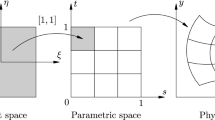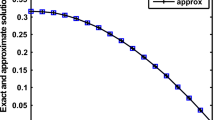Abstract
The boundary knot method (BKM) is a truly meshless boundary-type radial basis function (RBF) collocation scheme, where the general solution is employed instead of the fundamental solution to avoid the fictitious outside boundary of the physical domain of interest. In this study, the BKM is first used to calculate the free vibration of free and simply-supported thin plates. Compared with the analytical solution and ANSYS (a commercial FEM code) results, the present BKM is highly accurate and fast convergent.
Similar content being viewed by others
References
Zhang, Z., Gil, A.J., Hassan, O. and Morgan, K., The simulation of 3D unsteady incompressible flows with moving boundaries on unstructured meshes. Computers & Fluids, 2008, 37: 620–631.
Bodard, N., Bouffanais, R. and Deville, M., Solution of moving-boundary problems by the spectral element method. Applied Numerical Mathematics, 2008, 58: 968–984.
Krysl, P. and Belytschko, T., The element free Galerkin method for dynamic propagation of arbitrary 3D cracks. International Journal for Numerical Methods in Engineering, 1999, 44: 767–800.
Lancaster, P. and Salkauskas, K., Surfaces generated by moving least-squares methods. Mathematics of Computation, 1981, 37: 141–158.
Liu, W.K., Jun, S., Li, S., Adee, J. and Belyschko, T., Reproducing kernel particle methods for structural dynamics. International Journal for Numerical Methods in Engineering, 1995, 38: 1655–1679.
Golberg, M.A. and Chen, C.S., The method of fundamental solutions for potential, Helmholtz and diffusion problems. In: Boundary Integral Methods: Numerical and Mathematical Aspects. Southampton: Computational Mechanics Publications, 1998, 103–176.
Lothar, R., On the numerical solution of some 2-D electromagnetic interface problems by the boundary collocation method. Computer Methods in Applied Mechanics and Engineering, 1985, 53(1): 1–11.
Mukherjee, Y.X. and Mukherjee, S., The boundary node method for potential problems. International Journal for Numerical Methods in Engineering, 1997, 40: 797–815.
Chen, W., Symmetric boundary knot method. Engineering Analysis with Boundary Elements, 2002, 26(6): 489–494.
Chen, C.S., Rashed, Y.F. and Golberg, M.A., A mesh-free method for linear diffusion equation. Numerical Heat Transfer, 1998, 33: 469–486.
Golberg, M.A., Chen, C.S. and Ganesh, M., Particular solutions of 3D Helmholtz-type equations using compactly supported radial basis functions. Engineering Analysis with Boundary Elements, 2000, 24: 539–547.
Zhang, X., Song, K.Z., Lu, M.W. and Liu, X., Meshless methods based on collocation with radial basis functions. Computational Mechanics, 2000, 26: 333–343.
Kitagawa, T., Asymptotic stability of the fundamental solution method. Journal of Applied Mathematics and Computing, 1991, 38: 263–269.
Balakrishnan, K. and Ramachandran, P.A., The method of fundamental solutions for linear diffusion-reaction equations. Mathematical and Computer Modelling, 2001, 31: 221–237.
Hon, Y.C. and Chen, W., Boundary knot method for 2D and 3D Helmholtz and convection-diffusion problems under complicated geometry. International Journal for Numerical Methods in Engineering, 2003, 56: 1931–1948.
Kang, S.W., Lee, J.M. and Kang, Y.J., Vibration analysis of arbitrarily shaped membranes using non-dimensional dynamic influence function. Journal of Sound and Vibration, 1999, 221: 117–132.
Kang, S.W. and Lee, J.M., Free vibration analysis of arbitrary shaped plates with clamped edges using wave-type functions. Journal of Sound and Vibration, 2001, 241(1): 9–26.
Chen, J.T., Chen, I.L., Chen, K.H., Lee, Y.T. and Yeh, Y.T., A meshless method for free vibration analysis of circular and rectangular clamped plates using radial basis function. Engineering Analysis with Boundary Elements, 2004, 28: 535–545.
Chen, J.T., Chen, I.L., Chen, K.H. and Lee, Y.T., Comments on ‘Free vibration analysis of arbitrarily shaped plates with clamped edges using wave-type functions’. Journal of Sound and Vibration, 2003, 262: 370–378.
Chen, J.T., Chang, M.H., Chen, K.H. and Chen, I.L., The boundary collocation method with meshless concept for acoustic eigenanalysis of two-dimensional cavities using radial basis function. Journal of Sound and Vibration, 2002, 257(4): 667–711.
Kang, S.W. and Lee, J.M., Application of free vibration analysis of membranes using the non-dimensional dynamic influence function. Journal of Sound and Vibration, 2000, 234(3): 455–470.
Leissa, A.W., The free vibration of rectangular plates. Journal of Sound and Vibration, 1973, 3: 257–293.
Laura, P.A.A. and Bambill, D.V., Comments on ‘Free vibration analysis of arbitrarily shaped plates with clamped edges using wave-type functions’. Journal of Sound and Vibration, 2002, 252(1): 187–188.
Rokhlin, V., Rapid solution of integral equations of classical potential theory. Journal of Computational Physics, 1985, 60: 187–207.
Author information
Authors and Affiliations
Corresponding author
Additional information
Project supported by the National Natural Science Foundation of China (No.10672051).
Rights and permissions
About this article
Cite this article
Shi, J., Chen, W. & Wang, C. Free Vibration Analysis of Arbitrary Shaped Plates by Boundary Knot Method. Acta Mech. Solida Sin. 22, 328–336 (2009). https://doi.org/10.1016/S0894-9166(09)60281-0
Received:
Revised:
Published:
Issue Date:
DOI: https://doi.org/10.1016/S0894-9166(09)60281-0




